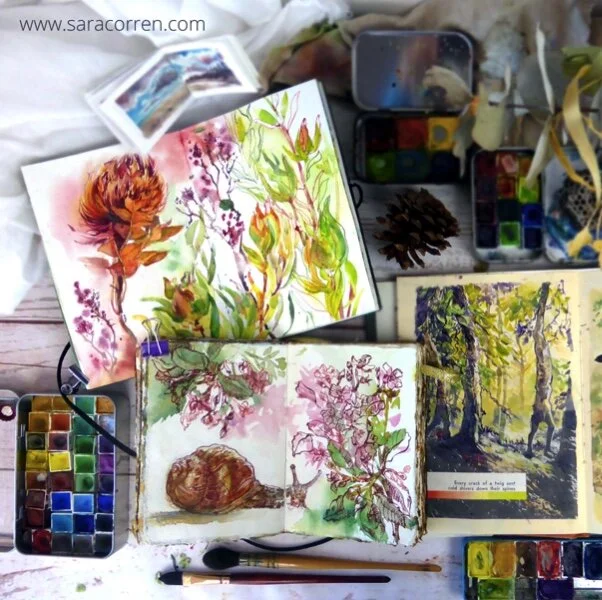For me, nature journaling is just as valuable as an indoor practice as it is an outdoor one. Stepping outside, to walk and discover a moment of calm in the natural world is a gift to oneself. Be it beside the beach or surrounded by trees, a stroll in the local park or contemplating a moody sky above while walking the dogs in suburbia can have an effect of peace and gratitude.
I find particularly in this time of COVID 19 and the global need for self-isolation practices, the appreciation of nature is even more heightened. This can happen in small ways. It can just be the practice of walking, noting what catches your eye and inspires you to want to document it further in your art. By picking up a fallen branch, a feather or a patterned stone and taking it back home and into the pages of my journal serves me as a time to study and reflect. The art of nature journaling is that of focus and meditation. To follow the spirals of a shell whorl, the clumps of lichen growth or the reflective colour of a dropped parrot feather is ultimately an appreciation of life and it’s intricacies.
I think the one singular activity that has helped my art practice is to keep a nature journal. It’s made me slow down and contemplate. It’s also made me more creative, for example, in taking a small clipping of wattle and subsequently building imagery around it in my sketchbook. If I can't sit directly outside, I can remember the bee that flew close to the wattle flower or the time of day and weather.
My medium of choice is watercolour and I find this to be perfect for re-creating the transient moods of nature as watercolour is also unpredictable and spontaneous. A container of water and a few portable colours outdoors is a great choice for documenting nature and it’s changing elements. Yet, as much as I like to work loosely, I also find the practice of a more detailed botanical study of a spider or a leaf in the studio gives me the confidence and better understanding of form and textures that I may not have had with time or weather constraints outside.
Having that time of reflection plus an on-going record in your journal is also a way of recognizing what attracts you in your art-making. Is it colour, texture or a particular subject like trees or birds? Inside my journals, I can look back at past work and see if my drawing style has changed or if there are certain motifs of the natural world I return to.
Most importantly, I love the process of nature journaling, sketching indoors and out. It makes me feel more connected to myself and the environment. It’s an opportunity to keep learning and growing and never to underestimate the living world. It’s made me appreciate not just a beautiful new flower but also the transient beauty of a faded and broken leaf. By bringing the outdoors in, nature journaling keeps me connected to what I most appreciate in the natural world.
More examples of Sara’s work and process can be found on her website www.saracorren.com and process on her Instagram Sara Corren (@saracorren).







